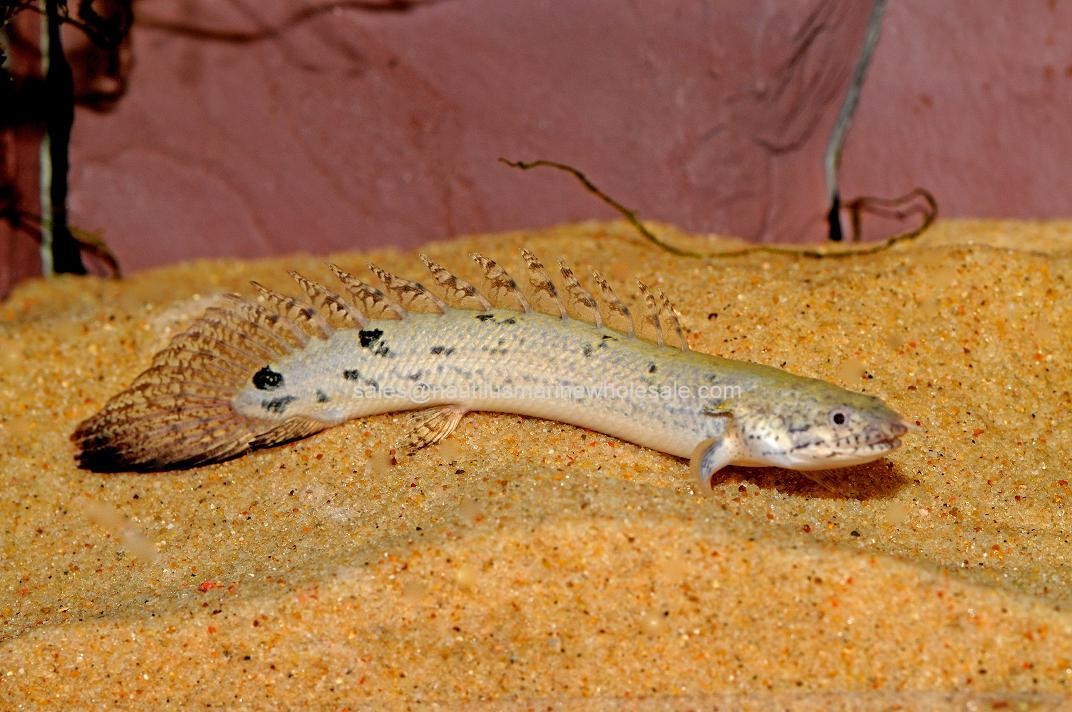SKU: H774
Arowana Care Tips
in stock
In Stock
Out of Stock
Temporarily Out of Stock
Discontinued
Special Order
Price:
Product Details
This beautiful fish can be found in many parts of the world, with to 2 genera and 6 species.
Silver Arowana (36-48") Osteoglossum bichirrhosum - South America
Black Arowana (36-48") Osteoglossum ferreirai - South America
Southern Saratoga (18-36") Scleropages leichardti - Australia
Northern Saratoga (18-24") Scleropages jardinii - Australia
Asian Arowana (24-36") Scleropages formosus - Asia
Myanmar Arowana (24-36") Scleropages inscriptus - Myanmar, Southeast Asia
General: These fish can make beautiful show fish if kept under the right conditions. Adults can grow from 18-48" depending on species.
Longevity: 5-20 years
Compatibility/Behavior: A slow moving top dwelling fish. Arowanas will not bother anything that they can not swallow. In the wild, they are ambush predators, waiting at the surface of the water for their prey to come. This leads to them being a more reclusive, stationary species. They are capable of jumping several meters in the air, so it is recommended that they are kept in a tank with a very tight lid.
Tank Conditions: Young specimens are very delicate and they can be housed in a minimum size of a 40 breeder. Keep in mind that these fish can grow 2 inches per month in their first year, so sizing up the tank may be necessary rather quickly. Make sure the tank has high flow, this can be done by using circulation pumps. A strong filter like a canister filter is recommended to keep up with the waste production. A tight fitting lid is necessary for this fish, as they are jumpers. Providing a tank that has many live plants and driftwood is the best for this fish, as this will replicate their natural environment.
Tank Sizing: This is a very large fish. Small, narrow tanks are not recommended. A minimum size of a 180 gallon long should be provided for this fish. Tank Dimensions: 72 x 24 x 24.
Temperature: 80-85F
Feeding: Feed once a day. Baby arowanas will absorb their yolk sac. Afterwards they can be given live brine shrimp. Once they reach a few inches in size they will accept live guppies. Adult arowanas will eat a variety of foods, we recommend live Rosey Red Minnows, Frozen Krill, and Frozen Silversides. In order to fill their desire for insects, Crickets and Mealworms can be offered as well. Some great dry food options include Sera Arowana Floating Pellets, Hikari Food Sticks, and Hikari Carnisticks (Ideal for Carnivorous Monster Fish), another great option is TetraCichlid Floating Cichlid Sticks. All of these food options are 40% or above in crude protein, and below 10% in crude fat.
Growth/Color: A quick grower that will grow as large as the tank allows. Large public aquariums have specimens that are 45" long.
Baby Arowanas: Young absorb yolk sac, and then begin to feed. Make sure to keep by themselves in a small tank until they are actively feeding on their own. Feed guppies, plankton, and brine shrimp. Also be sure to provide floating vegetation, and tall vegetation that reaches the surface, some suggestions are Pennywort, Vallisneria Gigantea, Anacharis, or Green Myrio Foxtail. Providing the young fish with natural hiding spaces at the surface is optimal.
Drop Eye Disease: Drop eye disease is when the eye, whether it be one eye or both eyes, appears to bulge out of of the head and be angled downward. This disease most commonly affects Arowanas and Arapaima. While researchers are not positive what the cause of this disease is yet, they do feel strongly that making sure to feed a low fat high protein diet is the best way to prevent this disease. Floating Sticks that are meant for arowanas or other monster fish are a great option for food choices. Refrain from feeding live goldfish, as they are a very fatty food with not much beneficial nutritional value.
Possible Tank Mates: A list of appropriate tank mates for Arowanas will be provided below. While an Arowana is capable of swallowing any tankmate that is small enough to fit in its mouth, be cautious not to house them with highly aggressive larger fish species, as this may intimidate the gentle natured Arowana.
Loaches/Eels: Fire Eel, Tire Track Eel, Black Ghost Knifefish, African Knifefish, Elephant Noses, Clown Loach.
Polypterus: angsorgii, bichir, congicus, delhezi, endlicheri, ornatipinnis, sengealus.
Larger Barbs/Tetras: Spanner T, Mascara, Tinfoil, Silver Dollar.
Gar: Florida Longnose, Spotted Gar, Needle Gar. (Make sure to have enough space in the tank to fit several very large fish)
Silver Arowana (36-48") Osteoglossum bichirrhosum - South America
Black Arowana (36-48") Osteoglossum ferreirai - South America
Southern Saratoga (18-36") Scleropages leichardti - Australia
Northern Saratoga (18-24") Scleropages jardinii - Australia
Asian Arowana (24-36") Scleropages formosus - Asia
Myanmar Arowana (24-36") Scleropages inscriptus - Myanmar, Southeast Asia
General: These fish can make beautiful show fish if kept under the right conditions. Adults can grow from 18-48" depending on species.
Longevity: 5-20 years
Compatibility/Behavior: A slow moving top dwelling fish. Arowanas will not bother anything that they can not swallow. In the wild, they are ambush predators, waiting at the surface of the water for their prey to come. This leads to them being a more reclusive, stationary species. They are capable of jumping several meters in the air, so it is recommended that they are kept in a tank with a very tight lid.
Tank Conditions: Young specimens are very delicate and they can be housed in a minimum size of a 40 breeder. Keep in mind that these fish can grow 2 inches per month in their first year, so sizing up the tank may be necessary rather quickly. Make sure the tank has high flow, this can be done by using circulation pumps. A strong filter like a canister filter is recommended to keep up with the waste production. A tight fitting lid is necessary for this fish, as they are jumpers. Providing a tank that has many live plants and driftwood is the best for this fish, as this will replicate their natural environment.
Tank Sizing: This is a very large fish. Small, narrow tanks are not recommended. A minimum size of a 180 gallon long should be provided for this fish. Tank Dimensions: 72 x 24 x 24.
Temperature: 80-85F
Feeding: Feed once a day. Baby arowanas will absorb their yolk sac. Afterwards they can be given live brine shrimp. Once they reach a few inches in size they will accept live guppies. Adult arowanas will eat a variety of foods, we recommend live Rosey Red Minnows, Frozen Krill, and Frozen Silversides. In order to fill their desire for insects, Crickets and Mealworms can be offered as well. Some great dry food options include Sera Arowana Floating Pellets, Hikari Food Sticks, and Hikari Carnisticks (Ideal for Carnivorous Monster Fish), another great option is TetraCichlid Floating Cichlid Sticks. All of these food options are 40% or above in crude protein, and below 10% in crude fat.
Growth/Color: A quick grower that will grow as large as the tank allows. Large public aquariums have specimens that are 45" long.
Baby Arowanas: Young absorb yolk sac, and then begin to feed. Make sure to keep by themselves in a small tank until they are actively feeding on their own. Feed guppies, plankton, and brine shrimp. Also be sure to provide floating vegetation, and tall vegetation that reaches the surface, some suggestions are Pennywort, Vallisneria Gigantea, Anacharis, or Green Myrio Foxtail. Providing the young fish with natural hiding spaces at the surface is optimal.
Drop Eye Disease: Drop eye disease is when the eye, whether it be one eye or both eyes, appears to bulge out of of the head and be angled downward. This disease most commonly affects Arowanas and Arapaima. While researchers are not positive what the cause of this disease is yet, they do feel strongly that making sure to feed a low fat high protein diet is the best way to prevent this disease. Floating Sticks that are meant for arowanas or other monster fish are a great option for food choices. Refrain from feeding live goldfish, as they are a very fatty food with not much beneficial nutritional value.
Possible Tank Mates: A list of appropriate tank mates for Arowanas will be provided below. While an Arowana is capable of swallowing any tankmate that is small enough to fit in its mouth, be cautious not to house them with highly aggressive larger fish species, as this may intimidate the gentle natured Arowana.
Loaches/Eels: Fire Eel, Tire Track Eel, Black Ghost Knifefish, African Knifefish, Elephant Noses, Clown Loach.
Polypterus: angsorgii, bichir, congicus, delhezi, endlicheri, ornatipinnis, sengealus.
Larger Barbs/Tetras: Spanner T, Mascara, Tinfoil, Silver Dollar.
Gar: Florida Longnose, Spotted Gar, Needle Gar. (Make sure to have enough space in the tank to fit several very large fish)
| Product PDF: | |
|---|---|
| Extra Details: |
Related Items:
| Item | Description | Quantity | Price | ||
| 122 |  |
Silver Arowana | out of stock | $59.99 | |
| 729 |  |
Clown Loach - Sm | out of stock | $13.99 | |
| 715 |  |
Black Ghost Knifefish | in stock | $19.99 | |
| 718 |  |
Clown Knifefish | out of stock | $27.99 | |
| 544 |  |
Fire Eel - small | out of stock | $59.99 | |
| 9485 |  |
Tire Track Eel | in stock | $49.99 | |
| 922 |  |
Silver Dollar | in stock | $7.99 | |
| 151 |  |
Tinfoil Barb | in stock | $8.99 | |
| 4169 |  |
Polypterus (Bichir) | out of stock | $14.99 | |
| 6589 |  |
Albino Bicher Polypterus | out of stock | $13.99 | |
| 2709 |  |
Endlicheri (Bichar) Polypterus | in stock | $28.99 | |
| 2319 |  |
Polypterus Delhezi | in stock | $31.99 | |
| 1619 |  |
Albino Polypterus | in stock | $57.99 | |
| 7799X |  |
Valisneria Gigantea Plant | out of stock | $5.99 | |
| P54 |  |
Green Myrio Foxtail Plant | in stock | $4.99 |

